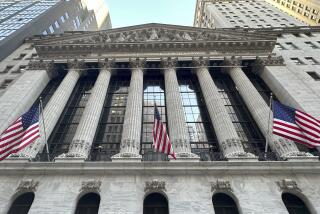Price Data Calms Markets, Leaves Investors Mystified
- Share via
Thanks to Tuesday’s report that producer prices declined in October, last week’s rise in interest rates looks like a hiccup, not a trend. The wholesale price report calmed inflation fears among money managers and sent bond markets rising again. Stocks were mixed, as relief about inflation mingled with concern for the sluggish economy.
But if finance professionals were relieved, ordinary investors are simply mystified, wondering one week whether to cash in their mutual fund and the next whether to refinance the house.
For the immediate future, the correct answer is refinance, but beyond that the key to living with uncertainty is to ignore month-to-month fluctuations and watch for signs of longer-term trends. When interest rates, and inflation, do reverse direction and start going up decisively, a pattern will be evident.
Economic growth will be strong--4% or better--for more than one quarter, inflation will rise consistently at more than a 3% annual rate and the Federal Reserve Board will act by raising short-term interest rates. But that time has not yet come.
“My guess is that a decisive rise in interest rates is a couple of years off,” says Albert M. Wojnilower, senior economist of Credit Suisse First Boston and a man who made a reputation as an economic predictor in the 1980s.
How can economists make such confident predictions? And how can others predict just the opposite for inflation? The simple answer is that the economy is big and complex, like a horse race at Santa Anita. You look for clues and draw conclusions.
The present, for example, remains slightly deflationary, with prices of industrial commodities falling over the last year and wages and home prices rising only modestly nationwide. That means “interest rates are not really low,” notes economist John Rutledge, head of the Greenwich, Conn., investment company bearing his name. “If you’re a business financing inventories that are declining in price, your effective interest rate is very high; the same goes for your mortgage if your home is declining in value.”
Deflation is not about to turn to inflation in a hurry, despite indications of shortages and rising prices cropping up as the economy appears to be adding $60 billion worth of goods and services in the final quarter of 1993--a 4% annual rate of growth.
*
To some, that signals a new direction. James Grant, editor of the Interest Rate Observer newsletter, notes shortages of such industrial materials as cement and paperboard and predicts a quickening of inflation and rising interest rates.
But what Grant really sees is evidence that the economy’s structure cannot accommodate rapid growth. If a 4% growth rate were to be sustained, we would quickly see a surge of imports from countries eager to sell into the big U.S. market. That could create other problems.
In reality, the outlook is for the economy to slow down early next year and to continue bumping along--a recovery that is neither thrilling nor depressing, but frustrating. Companies must continually cut costs, jobs are not plentiful and nobody is generous with pay or benefits. And banks paying less than 3% on certificates of deposit push savers into riskier investments.
That’s why money has flowed into mutual funds, driving stocks to new highs and taking U.S. investments to such exotic climes as the emerging markets of Asia. Frankly, say many investment managers, American money is distorting Asian markets, bidding prices way beyond underlying economic growth. A shakeout is coming in those markets.
*
The crosscurrents remind some of the 1920s, a decade that started with a deep recession and then knew years of declining interest rates and rising stock prices. American investors bought Chinese and Bolivian government bonds, which later became worthless.
The U.S. economy was restructuring away from agriculture in the 1920s, as today it is shifting out of a 50-year focus on defense industries. Parallels can be ominous: The ‘20s ended with a great crash in the stock market after investors grew bubbly with dreams of getting rich.
We have no bubble yet in the ‘90s. People don’t think they’ll get rich; in fact, they’re working increasingly at personal service jobs--which is ironic. Back in the ‘70s and ‘80s, the cry of those who feared for the economy’s future was “We’ll end up taking in each other’s washing.” Well, that’s happening--as more Americans give each other legal, medical, financial and psychological advice, or teach, train, protect and serve each other. The waiter singing out daily specials has become a cliche of American life.
What comes next we don’t know for sure, but down the road there will probably be a bubbling of the economy, rising interest rates and a deep decline in the stock market.
*
That time is not now--even though a chain called Boston Chicken opened trading at $20 a share and shot to $48.50 on Tuesday. Bonds continue to do well, stocks are getting support and houses are for refinancing, not for selling. Some experts even argue that interest rates will go lower next year. But that’s what makes horse races.
Producer Price Index:
Seasonally adjusted change from prior month. For full story on producer prices, see D2.
Source: U.S. Department of Labor
More to Read
Inside the business of entertainment
The Wide Shot brings you news, analysis and insights on everything from streaming wars to production — and what it all means for the future.
You may occasionally receive promotional content from the Los Angeles Times.










